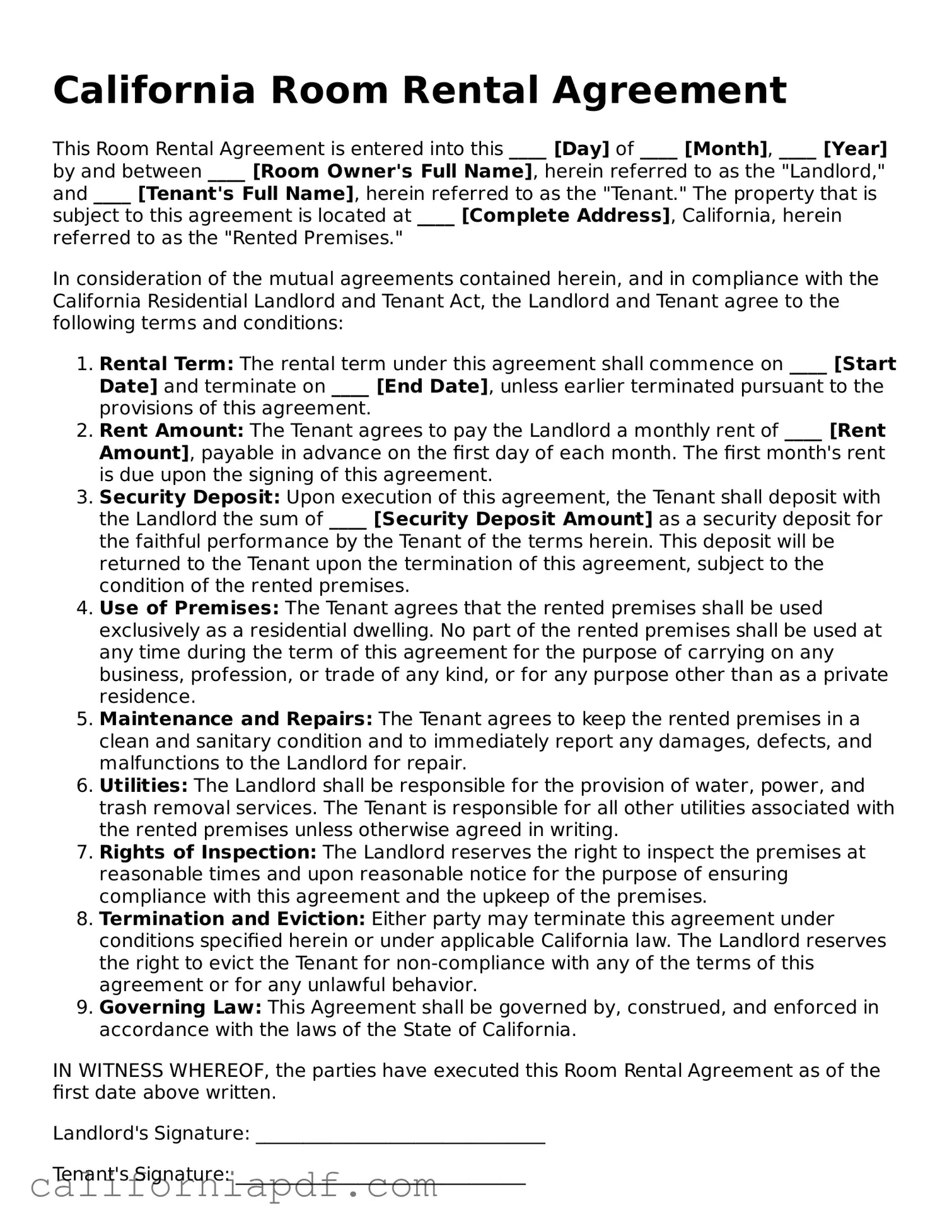The California Room Rental Agreement form shares similarities with the Residential Lease Agreement, primarily in its function to establish the terms under which a renter can occupy residential property. However, while a Room Rental Agreement tends to focus on the renting of a single room within a dwelling, a Residential Lease Agreement usually covers the rental of an entire property. Both documents serve to protect the rights and responsibilities of both parties and set forth conditions such as payment, duration of the lease, and rules for living arrangements.
Similarly, the Sublease Agreement is another document that mirrors aspects of the California Room Rental Agreement. A Sublease Agreement comes into play when an original tenant wants to rent out their leased premises to another tenant. Like the Room Rental Agreement, it outlines terms related to rent, utilities, and other conditions of staying in the property. However, it introduces a third party into the rental equation, adding layers of responsibility and rights among the original lessor, lessee, and sublessee.
The California Month-to-Month Rental Agreement also shares characteristics with the Room Rental Agreement, particularly in its provision for flexibility. Unlike traditional lease agreements that may lock parties into year-long commitments, both these documents can offer month-to-month arrangements, allowing for easier termination of the agreement by either party with proper notice. This similarity provides tenants and landlords with greater adaptability to changing circumstances.
Co-Tenancy Agreements, though less common, echo elements found in the California Room Rental Agreement. These are used when multiple individuals agree to rent a property together, sharing financial responsibilities and living spaces. Both agreements manage living arrangements in shared spaces but from different angles: while the Room Rental Agreement may involve one landlord and one tenant for a single room, Co-Tenancy Agreements involve multiple tenants sharing broader responsibilities for the entire property.
Lodger Agreements in California are also akin to Room Rental Agreements. These are specific to situations where the homeowner rents out part of their residence to a lodger. Both documents outline the use of part of a dwelling (such as a room) and the sharing of common areas. The key distinction lies in the presence of the owner on the premises in a Lodger Agreement, which may affect legal rights and obligations in ways not typically encountered in a standard Room Rental Agreement.
Property Management Agreements bear resemblance too, as they are designed to formalize the arrangement between a property owner and a manager who oversees the rental. While the Room Rental Agreement directly concerns the relationship between landlord and tenant, the Property Management Agreement delineates how a property manager fits into the rental process, including their responsibilities in managing rentals, which may include executing Room Rental Agreements on behalf of the owner.
A Tenant in Common Agreement shares a foundational concept with the California Room Rental Agreement in terms of shared space but diverges in its focus on ownership rather than rental. It is used when two or more parties own a property together without survivorship rights. Though it deals with the ownership and use of shared spaces rather than rental, the dynamics of shared responsibilities and rights underlie both documents.
Lease Renewal Agreements and the California Room Rental Agreement also share common ground. When a lease term comes to an end, and both parties wish to continue the rental arrangement, a Lease Renewal Agreement is often executed. This mirrors the Room Rental Agreement’s capacity for renewal upon the agreement of both parties but specifically pertains to the continuation of an existing lease rather than the commencement of a new tenant-landlord relationship.
The Eviction Notice, while seemingly quite different, is related in the context of enforcing the terms outlined in a Room Rental Agreement. Should a tenant violate the terms of their agreement, an Eviction Notice is the formal document a landlord uses to begin the process of removing a tenant from the property. It ties directly back to the Room Rental Agreement since adherence to the agreement’s terms can prevent the issuance of such a notice.
Lastly, the Roommate Agreement is closely related to the California Room Rental Agreement, albeit with a focus on arrangements between roommates rather than between landlord and tenant. This document outlines how roommates will share rent, utilities, chores, and resolve disputes. While both promote a harmonious living situation, the Roommate Agreement is unique in that it does not establish a relationship with the property owner but instead focuses on the relationship among the tenants themselves.
